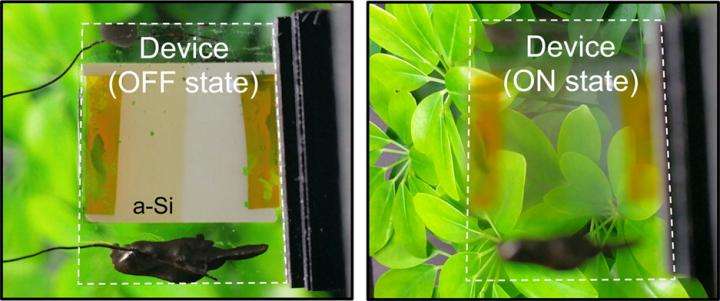Solar smart window could offer privacy and light control on demand

Smart windows get darker to filter out the sun's rays on bright days, and turn clear on cloudy days to let more light in. This feature can help control indoor temperatures and offers some privacy without resorting to aids such as mini-blinds. Now scientists report a new development in this growing niche: solar smart windows that can turn opaque on demand and even power other devices. The study appears in ACS Photonics.
Most existing solar-powered smart windows are designed to respond automatically to changing conditions, such as light or heat. But this means that on cool or cloudy days, consumers can't flip a switch and tint the windows for privacy. Also, these devices often operate on a mere fraction of the light energy they are exposed to while the rest gets absorbed by the windows. This heats them up, which can add warmth to a room that the windows are supposed to help keep cool. Jeremy Munday and colleagues wanted to address these limitations.
The researchers created a new smart window by sandwiching a polymer matrix containing microdroplets of liquid crystal materials, and an amorphous silicon layer—the type often used in solar cells—between two glass panes. When the window is "off," the liquid crystals scatter light, making the glass opaque. The silicon layer absorbs the light and provides the low power needed to align the crystals so light can pass through and make the window transparent when the window is turned "on" by the user. The extra energy that doesn't go toward operating the window is harvested and could be redirected to power other devices, such as lights, TVs or smartphones, the researchers say.
More information: Joseph Murray et al. Electrically Controllable Light Trapping for Self-Powered Switchable Solar Windows, ACS Photonics (2016). DOI: 10.1021/acsphotonics.6b00518
Abstract
The ability to electrically control transparency and scattering of light is important for many optoelectronic devices; however, such versatility usually comes with additional unwanted optical absorption and power loss. Here we present a hybrid switchable solar window device based on polymer dispersed liquid crystals (PDLCs) coupled to a semiconducting absorber, which can switch between highly transmissive and highly scattering states while simultaneously generating power. By applying a voltage across the PDLC layer, the device switches from an opaque, light-scattering structure (useful for room light dimming, privacy, and temperature control) to a clear, transparent window. Further, enabled by the very low operating power requirements of the PDLC (<0.8 mW/cm2), we demonstrate that these switchable solar windows have the potential for self-powering with as little as 13 nm of a-Si.
Journal information: ACS Photonics
Provided by American Chemical Society

















